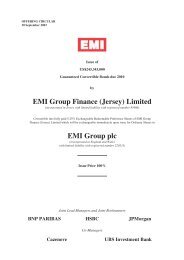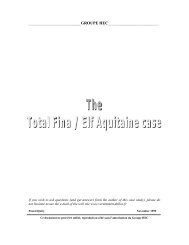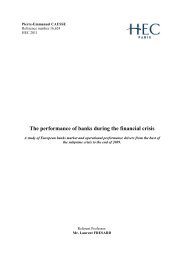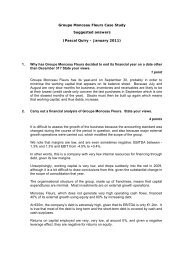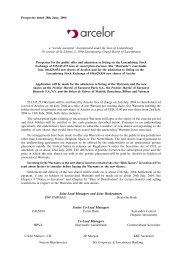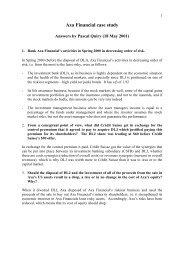Thesis_gd_final_vers.. - Vernimmen
Thesis_gd_final_vers.. - Vernimmen
Thesis_gd_final_vers.. - Vernimmen
You also want an ePaper? Increase the reach of your titles
YUMPU automatically turns print PDFs into web optimized ePapers that Google loves.
6) Conclusion<br />
The subprime crisis has been the culminating point of a major evolution phase of the US banking<br />
industry which has been driven by a long deregulation movement, the rise of information<br />
technologies, and the implementation of new financial products. While major changes such as<br />
securitization are helpful to understand the credit and real estate bubbles and their subsequent<br />
bursts, or even Lehman Brothers or Bear Stearns bankruptcies, they seem to be less pertinent in<br />
explaining the determinants of US regional bank failures.<br />
Failed US regional banks have been caught in a credit crisis. Based on our results, we think that<br />
the banks with both the riskiest loan categories allocation and the worst loan quality have failed.<br />
We find that before the crisis failed banks were normal or difficult to distinguish from safe<br />
banks back in 2005 and 2006 based on capital ratios or profitability measures. It is true that they<br />
were exposed to a stronger liquidity risk. But we interpret their financing structure as the<br />
consequence of their stronger asset growth. The beginning of the crisis is linked to a progressive<br />
deterioration of their capital ratios, non-performing loans, and profitability measures. This<br />
deterioration tends to accelerate as bankruptcy gets closer. These symptoms, as we call them, are<br />
the direct explanation of bankruptcy, and are well captured by our dynamic logistic regression<br />
model. A profitability measure such the net income ratio, an asset quality measure such as the nonperforming<br />
loan ratio or a liquidity measure such as the level of non-core deposits had already<br />
been found significant by Cole and Wu (2009) who examine bank failures between 1890 and 1995.<br />
The variables that measure the degradation of a bank situation and lead to bankruptcy are thus<br />
consistent over time and remain the same despite different environments. However these<br />
symptoms are often observable not very long before failure.<br />
Moreover we try to determine the causes of bank failures, i.e. characteristics that were<br />
observable before the crisis and could have been an early-warning of bankruptcy risk. Our<br />
hypothesis is that failing banks asset-mix overweighted loans in general and real estate loans more<br />
specifically to the detriment of securities. This is not well captured by our first logistic regression<br />
models, and we added a “crisis” effect, simply simulated through a crisis variable, which partly<br />
confirms our hypotheses but do not prove statistically significant. We then performed dynamic<br />
regressions on the level on non-performing loans and net interest income that verifies that the<br />
asset allocation of failed banks is partly explaining the evolution of these two direct dri<strong>vers</strong> of<br />
bankruptcy. Based on the results of our regression we can say that other elements explain the<br />
degradation of profitability and asset quality ratios over time. We think that more detailed asset<br />
- 51 -



